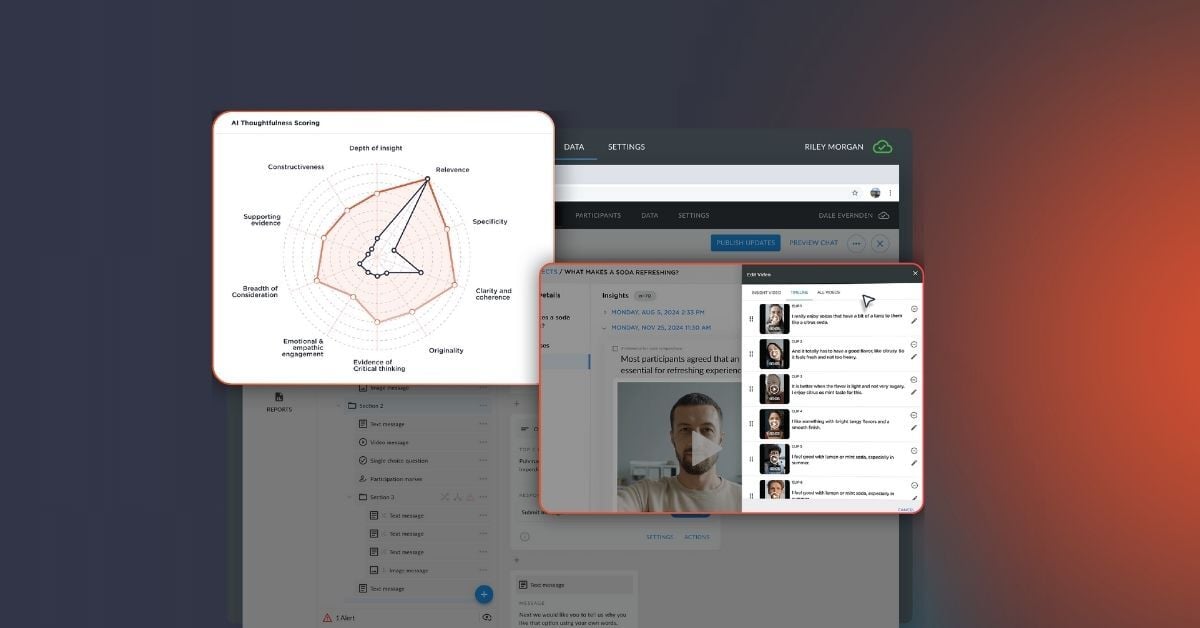
Unstructured data is a treasure trove for qualitative researchers—but it’s often a logistical nightmare. Open-ends, video feedback, social posts: all rich with insight, yet time-consuming to analyze. That’s why more insights teams are turning to AI—not as a shortcut, but as a strategic advantage.
In this blog, we explore how AI tools for qualitative research can help you scale analysis, improve rigor, and enhance storytelling—faster. It’s a companion to our full guide, From Chaos to Clarity, which unpacks how brands like ŌURA are using AI and agents to elevate every step of the qual research process. Download the ebook here to dive deeper.
Let’s start with the obvious: qual research is powerful but can be slow. Even experienced teams struggle to keep up with growing volumes of unstructured customer feedback. Sorting transcripts, coding responses, reviewing videos, and summarizing themes takes time—time you often don’t have.
AI research tools are flipping that equation. With capabilities like smart summarization, dynamic probing, and real-time reporting, AI opens up possibilities to help your team handle more qual projects without sacrificing quality or depth.
And it’s not just marketing hype. A research study published in Qualitative Inquiry found that large language models (LLMs) can help researchers explore patterns in qualitative data and even support iterative hypothesis testing in real time. When used thoughtfully, AI isn’t just fast—it’s smart.
If you’ve used AI for transcription or clustering, you’ve seen automation in action. But agentic AI is the next level.
Agentic AI systems rely on autonomous software “agents” that operate independently to complete multi-step tasks. In research, that means:
Think of these agents as intelligent collaborators—not just tools, but teammates.
Recent academic work supports this idea. An arXiv study on human-AI collaboration in thematic analysis found that when researchers worked with generative models, they explored more data and generated stronger early-stage insights, all while staying in control of interpretation.
In other words, agentic AI doesn’t replace researchers—it augments your superpowers to help you with the insight-generation process.
Adding AI to your qual research toolkit doesn’t mean handing over the keys. Here’s how to stay in the driver’s seat:
Authentic, in-the-moment feedback produces better AI results. A study from Wharton found that people share more deeply when responding via mobile instead of PC. So if you want to feed AI with high-quality data, consider using SMS surveys and other tools that helps you meet people where they are. A conversational approach also improves the participant experience, which is critical to capturing authentic qual feedback.
AI-generated summaries and themes are a great starting point, but generative AI is probabilistic, so it can make mistakes. When using a market research platform with AI capabilities, make sure human oversight is part of the process to ensures accuracy and contextual nuance.
Tell your stakeholders how AI was used in your qual research. It builds trust, manages expectations, and shows that your insights are both tech-enhanced and researcher-led.
Many of the best market research platforms today offer a range of modular AI capabilities.
The Rival platform, for example, offers a growing list of AI features. Thoughtfulness Scoring uses AI to evaluate depth, relevance, and quality of open-ends based on proprietary criteria. Smart AI Probe Text generates contextual follow-up questions that go deeper, using Thoughtfulness Scoring to decide when those follow-ups are necessary. (More info about these AI capabilities below.)
/rival-group-ai-panel-1.png?width=1085&height=904&name=rival-group-ai-panel-1.png)
There are also AI research capabilities for survey authoring and even making surveys more conversational. These AI tools for qual work independently—but as you’ll see below, they work best together in agentic systems where tasks are coordinated seamlessly.

Innovative research teams from companies like ŌURA and Sekisui House are already piloting and testing these AI capabilities. In one experiment, ŌURA used both Thoughtfulness Scoring and Smart AI Probe Text and saw significant improvements in feedback quality and relevance—a 293% improvement in Thoughtfulness Scores—without affecting the participant experience.
Sekisui House, on the other hand, found that Smart AI Probe Text is “a game-changer in categories with emotional connections.”
In both of these AI case studies, keeping humans in the loop remained critical.
“AI alone can’t interpret nuanced, context-heavy data,” said Jason Jacobson, Senior Director of Consumer Insights at Sekisui House. “The human touch ensures the right questions are asked at the right time, improving both the efficiency and authenticity of the insights. Rival has done a great job striking that balance—it feels less like automation and more like augmentation.”
The Unstructured Data Agent is Rival’s purpose-built, agentic AI system for qual research. It's part of our Multi-Agent Framework —a modular, scalable system of AI Agents designed to enhance every stage of the research process.

The Unstructured Data Agent integrates three smart agents to manage the qualitative research workflow:
Thoughtfulness Score: Rival's proprietary metric evaluates the relevance, specificity, clarity, and empathic engagement of open-end responses. This score ensures that AI-driven probing happens only when it makes sense for the participant. By minimizing redundancy and improving conversational flow, Thoughtfulness Scoring makes participants feel valued and helps researchers receive meaningful, actionable insights. Watch a short demo here.
Smart AI Probe Text: This feature dynamically follows up on survey responses in real time, using intelligent, context-aware prompts to uncover deeper insights without disrupting the conversation. On the Rival platform, you can set Smart AI Probe Text to trigger only if the Thoughtfulness Score falls below a predetermined threshold. Watch a short demo here.
AI Summarizer: A generative AI tool that distills large sets of open-text, qualitative data into clear, actionable themes—ideal for projects with high volumes of video and text responses. Watch a short demo here.
Insight Reels: Automatically turns video and text responses into curated highlight reels. Insight Reels uses AI to analyze and summarize open-ends, with human-in-the-loop affordances to customize and refine storytelling. Watch a short demo here.
AI Insight Report: Compiles all collected and summarized data into a polished, shareable deliverable—designed for mobile viewing and stakeholder engagement. It highlights key themes backed by participant quotes and video reels, includes a visual breakdown of response volumes by theme, and features a dynamic video summary that brings the story to life. This report makes it easy for research teams to quickly communicate findings, drive alignment, and move from insight to action—without spending hours formatting decks or sifting through raw data.
In addition to tools designed specifically for unstructured data, there's a growing suite of AI-powered features coming that will help enhance qual research and the broader insight-gathering journey. Looking ahead, Rival's AI Super Agent will provide full lifecycle support—coordinating across tasks, learning from each iteration, and helping insight teams move with greater speed and clarity.
As technology continues to advance, the potential for what agentic AI can deliver for insights professionals will only grow.
AI tools for qualitative research aren’t a magic bullet—but when used right, they can help with your insight community and other research initiatives. When paired with your expertise, AI can help you deliver insights faster, tell richer stories, and meet rising demands without burnout. And with agentic AI, you’re not just adopting tools—you’re building a smarter, more sustainable workflow.
Download the full guide, From Chaos to Clarity, for real-world examples, tactical advice, and a breakdown of how top brands are making AI work for them.
👉 Apply for Rival's AI Early Access program to start using our suite of AI agents and tools and help us shape the future of research tech innovation today!
Subscribe to our blog to receive the latest news, trends and best practices from market research experts.


No Comments Yet
Let us know what you think